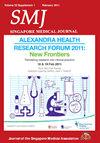新加坡成年癌症幸存者的财务毒性:是否存在?
IF 1.7
4区 医学
Q2 MEDICINE, GENERAL & INTERNAL
引用次数: 0
摘要
癌症幸存者可能会因诊断、治疗和潜在的失业而产生经济负担(FT)。在新加坡医疗保健模式下,经济毒性的发生率尚不清楚。我们调查了自付费用(OOP)较高是否与经济毒性呈正相关,以及较高的经济毒性是否与较差的生活质量(QoL)相关。 在这项试点研究中,我们对新加坡国立大学医院的鼻咽癌或乳腺癌幸存者进行了横断面调查。采用经济毒性综合评分(COST)和癌症治疗功能评估(FACT-G)问卷对患者的FT和QoL进行了测量。两个多变量回归模型估算了(a)FT与一系列变量之间的关系,以及(b)FT与QoL之间的关系。 在我们的 76 名患者中,有 63% 的患者经历过轻度-中度 FT。总体而言,COST 和 FACT-G 的平均得分分别为 18.0 分(总分 44 分)和 68.3 分(总分 108 分)。COST 和 FACT-G 评分之间呈正相关(r = 0.45)。我们没有发现 OOP 支出与 FT 之间有任何明显的关联。预测 FT 的因素包括政府补贴的住房、较低的教育水平、雇用正式的护理人员以及家庭成员需要从事额外工作。 家庭负担越重,生活质量越差。社会经济地位较低的患者发生家庭负担的风险较高。自费项目支出与家庭病床没有直接关系,这可能是考虑到有效的经济情况调查补贴。应考虑为这一高危人群提供额外资源。根据这项试点研究,我们量化家庭病史和自费项目支出的方法可推广到其他癌症初诊患者。本文章由计算机程序翻译,如有差异,请以英文原文为准。
Financial toxicity among adult cancer survivors in Singapore: does it exist?
Cancer survivors may experience financial toxicity (FT) arising from diagnosis, treatment and potential employment loss. The prevalence of FT in the context of Singapore healthcare model is unknown. We investigate whether higher out-of-pocket (OOP) expenditure correlates positively with FT, and whether higher FT correlates with a worse quality of life (QoL). In this pilot study, a cross-sectional survey was conducted on survivors of nasopharyngeal or breast cancer at the National University Hospital Singapore. Patients’ FT and QoL were measured using the COmprehensive Score on financial Toxicity (COST) and Functional Assessment of Cancer Therapy-General (FACT-G) questionnaires. Two multivariate regression models estimated (a) the association between FT and a range of variables, and (b) the association between FT and QoL. Sixty-three percent of our cohort of 76 patients experienced mild–moderate FT. Overall, the mean COST and FACT-G scores were 18.0 (out of 44) and 68.3 (out of 108), respectively. There was a positive correlation between COST and FACT-G scores (r = 0.45). We did not find any significant association between OOP expenditure and FT. Predictors for FT included government-subsidised housing, lower education levels, hire of a formal caregiver and the need for household members to take on extra employment. Greater FT correlated with a decline in QoL. Patients of lower socioeconomic status were at higher risk of FT. OOP expenditure was not directed related to FT, likely in view of the effective means-tested subsidies. Additional resources should be considered for this at-risk population. Based on this pilot study, our methodology to quantify FT and OOP expenditure can be scaled up to other cancer primaries.
求助全文
通过发布文献求助,成功后即可免费获取论文全文。
去求助
来源期刊

Singapore medical journal
MEDICINE, GENERAL & INTERNAL-
CiteScore
3.40
自引率
3.70%
发文量
149
审稿时长
3-6 weeks
期刊介绍:
The Singapore Medical Journal (SMJ) is the monthly publication of Singapore Medical Association (SMA). The Journal aims to advance medical practice and clinical research by publishing high-quality articles that add to the clinical knowledge of physicians in Singapore and worldwide.
SMJ is a general medical journal that focuses on all aspects of human health. The Journal publishes commissioned reviews, commentaries and editorials, original research, a small number of outstanding case reports, continuing medical education articles (ECG Series, Clinics in Diagnostic Imaging, Pictorial Essays, Practice Integration & Life-long Learning [PILL] Series), and short communications in the form of letters to the editor.
 求助内容:
求助内容: 应助结果提醒方式:
应助结果提醒方式:


